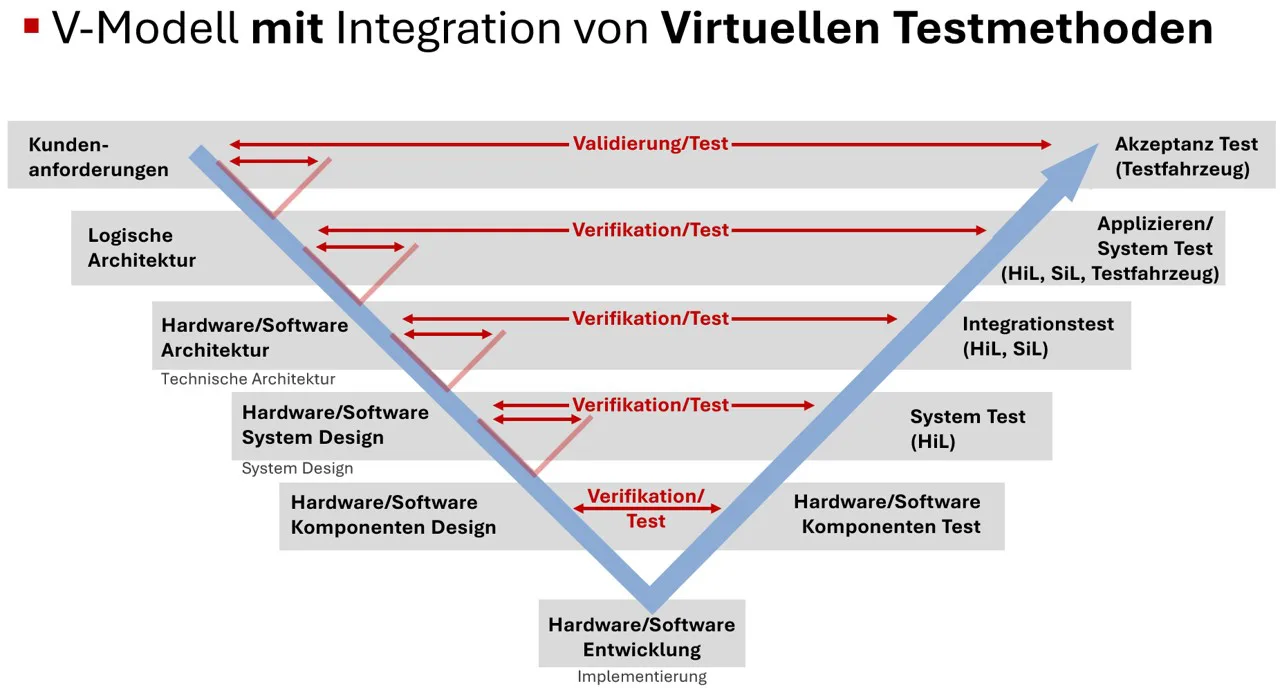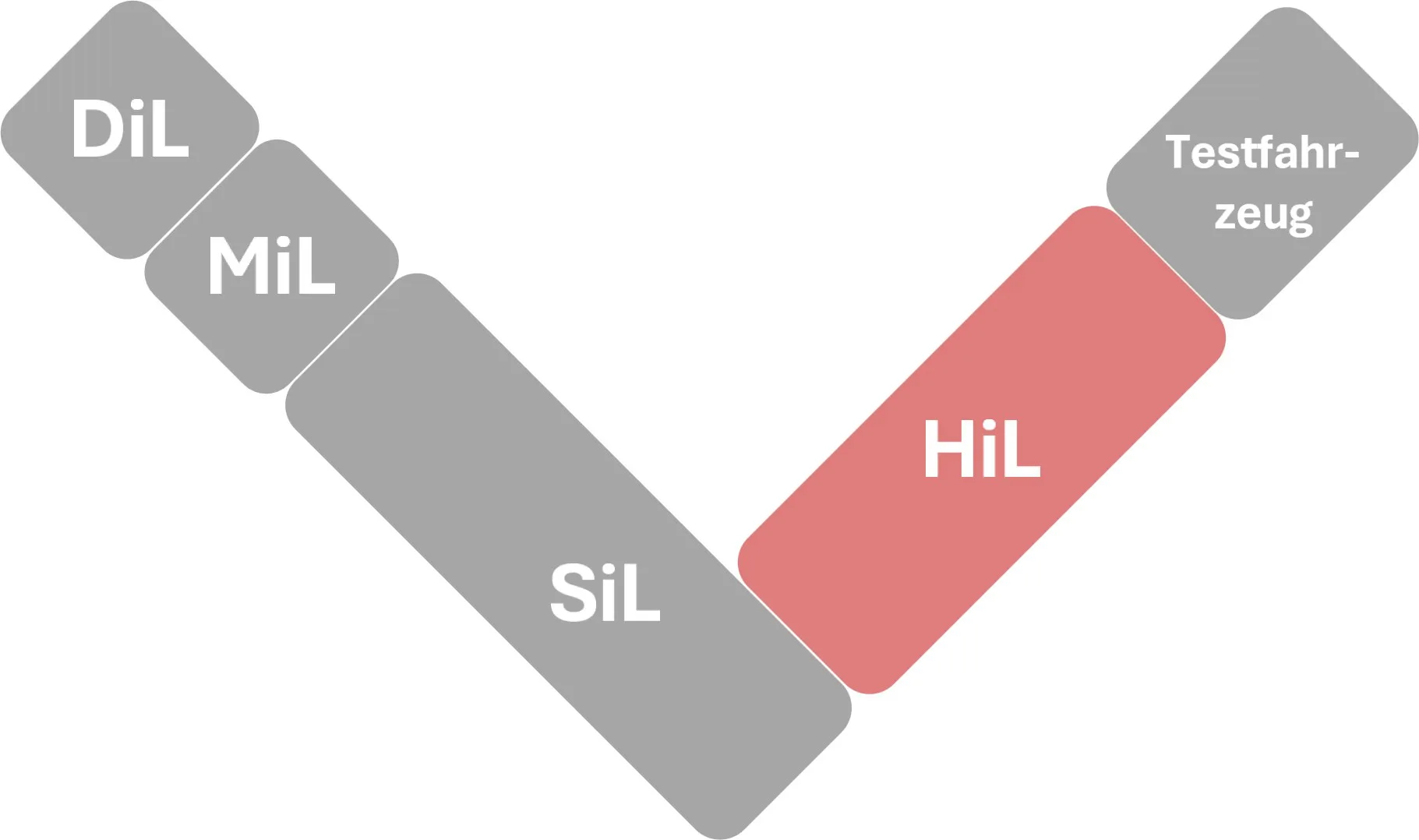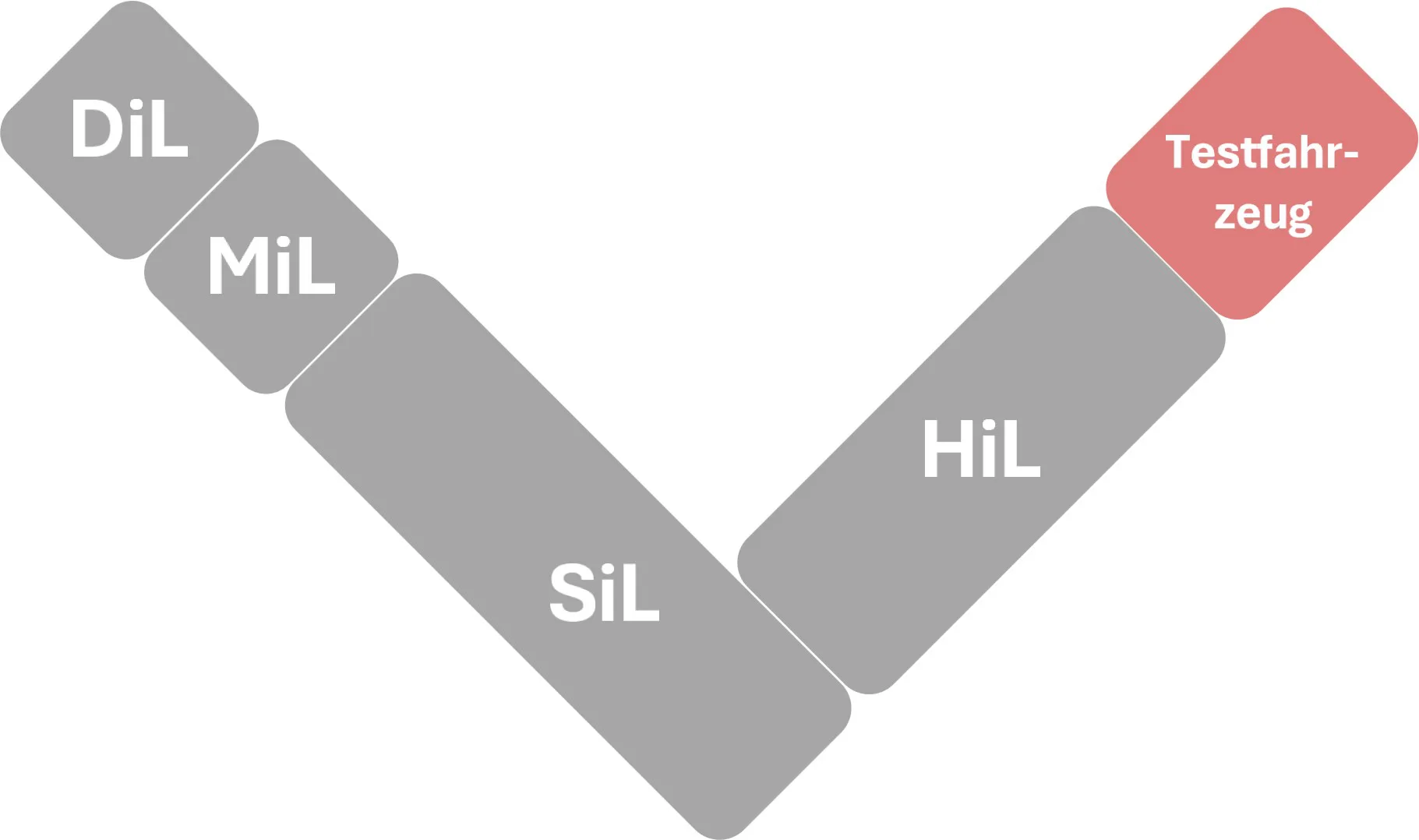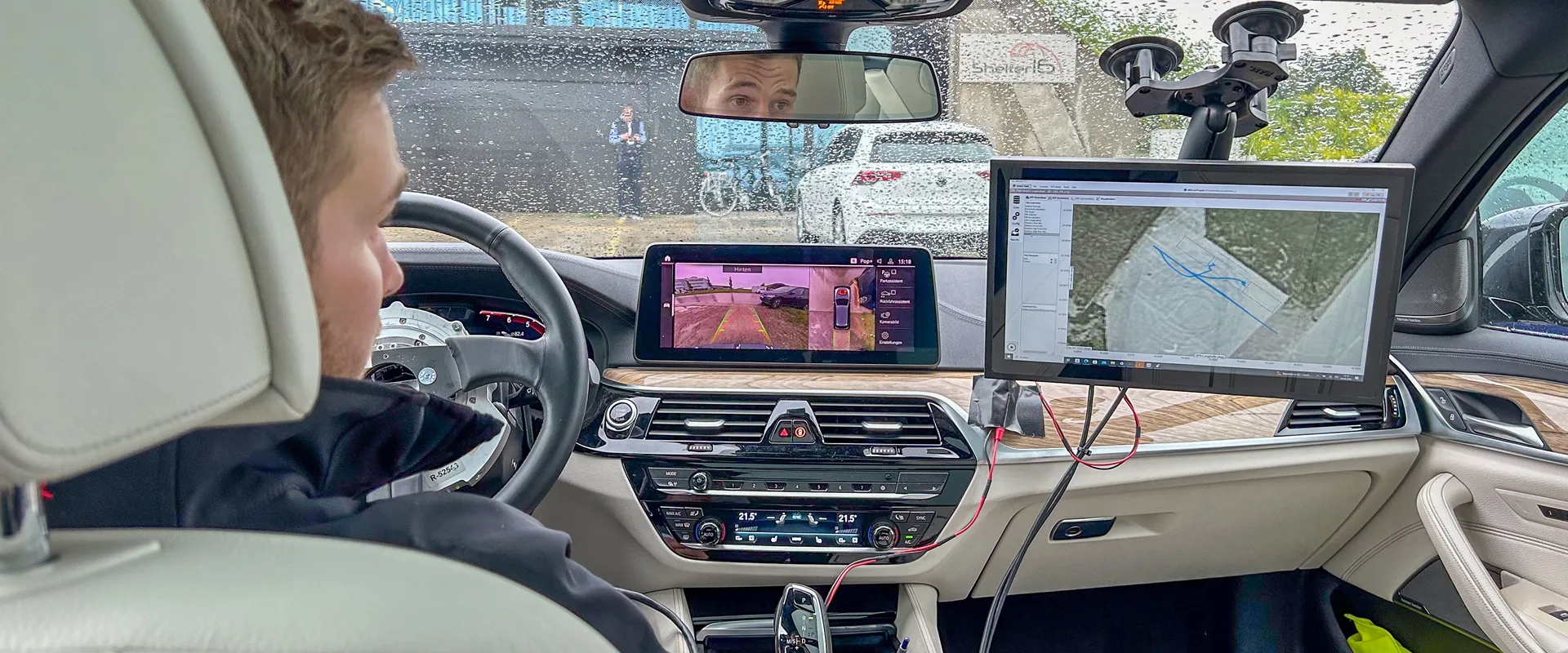Start / R+D Services / Vehicle Testing + Objectification
Precise tests, innovative software and close collaboration with test centres
Tailor-made vehicle testing + objectification for maximum safety, performance and compliance
Our vehicle testing + objectification offering includes a wide range of specialised services designed to optimise vehicle safety, performance and compliance to the highest levels. We offer tailor-made solutions for the precise execution of Advanced Driver Assistance Systems (ADAS) tests, as well as the development and application of advanced measurement technology and evaluation solutions.
With our expertise, we can help you conduct simulations, real-world driving tests and CoP tests (Conformity of Production) to ensure that your vehicles are always compliant. Of particular note is the use of our innovative MXeval software solution, which enables detailed analysis and evaluation of test data, helping you to accurately assess the performance of your vehicles.
We work closely with recognised testing organisations to ensure objective, reliable and neutral results. Our aim is to help vehicle manufacturers optimise their driver assistance systems and improve their Euro NCAP ratings. This ensures that your vehicles meet the highest standards of safety, efficiency and market requirements.
R&D services in vehicle testing + objectification
Our services are diverse and modular, encompassing user experience (UX) evaluation, comprehensive studies on customer and market research, benchmarks, data analysis and professional consulting. Our expertise extends beyond national borders. With our intercultural expertise and knowledge of different markets and cultures, we adapt our methods and approaches to the situation. This is because an ADAS function must exhibit different characteristics in various markets and cultural contexts and cannot be applied uniformly to every market.
Subjective perception and objective evaluation in a holistic approach
Our approach combines KPI-based, objective evaluation with the correlation of subjective perceptions. This allows us to build a holistic picture of the user experience. Our analyses result in new target values and clear recommendations for action, helping our clients to optimally align their products and services with their end users and achieve a brand-specific expression (brand DNA).
V&V process (verification & validation) – simulation, driving simulator & real-world testing in a seamless toolchain
- How do you ensure that your driving function meets all functional and non-functional requirements?
- Are your component interfaces compatible and robust?
- How reliable is your function’s driving behavior in real-world scenarios?
- How can test effort be minimized without compromising quality?
Too little simulation, testing too late in vehicle development
Why V&V validation needs to be rethought
Verification and validation of driving functions still occur too late in the vehicle development process. Critical issues are often only discovered on the road, leading to costly prototype modifications. However, modern simulations offer an efficient alternative: A seamless V&V validation approach that integrates simulation, driving simulators, and real-world testing to detect errors early, reduce the need for extensive test drives, and ensure continuous maturity development. This not only accelerates the development process but also significantly improves the quality and safety of driving functions.

Seamless V&V process from simulation to the road
We support you in all phases of V&V process– from concept development to resource planning, project management, and implementation. Our integrated toolchain covers all relevant development stages, ensuring efficient validation by combining simulation, dynamic driving simulators, and real-world testing.
Seamless Validation with SiL, MiL, and HiL
By utilizing SiL (Software-in-the-Loop), MiL (Model-in-the-Loop), and HiL (Hardware-in-the-Loop), we can significantly shorten the development process and validate the quality of driving functions at an early stage.
Dynamic Driving Simulator with HiL Integration
Our dynamic driving simulator enables both static and dynamic tests with full HiL integration. This allows complex scenarios to be tested under realistic conditions, ensuring highly reliable results.
Powerful Simulation Environments
Through model integration, validation, and the creation of detailed sensor models, we create realistic test conditions that enable precise analyses.
Ground Truth Routes for Seamless Validation
Our virtual tests are based on the exact same routes used in real-world driving tests. This ensures higher accuracy and comparability of results.
Standardized and Reproducible Tests
With structured KPI, maneuver, scenario, and route catalogs, test processes can be automated and analyzed with precision.
Our goal is to shift as many validation activities as possible from the right to the left side of the V-model, reducing the need for complex prototypes and extensive real-world testing—leading to a faster, more efficient, and higher-quality development process.
From individual modules to full vehicle testing – comprehensive validation
We offer verification and validation at every level with our seamless toolchain, covering individual driver assistance functions as well as fleet testing.

Simulation of ADAS System Behavior – Detailed analysis and optimization of driver assistance systems in a virtual environment.

Function Validation – Verification and validation of individual vehicle functions under realistic conditions.

Full Vehicle Validation – Ensuring the integration of all functions within the vehicle.
Regional Compliance Testing (EU, NAR, CN, SAR, Japan, South Korea) – Compliance testing with country-specific regulations and requirements.
Fleet Testing (Vehicle Collection Testing) – Real-world testing with multiple vehicles for long-term analysis and series production readiness.
Added Value of V&V process
- Early maturity development: Modern simulations help identify critical issues at an early stage.
- Efficient test processes: Standardized and reproducible tests reduce the need for complex prototypes.
- Seamless toolchain: A combination of simulation, dynamic driving simulators, and real-world tests ensures continuous quality.
- Integrated test methods: The use of SiL, MiL, and HiL enables early validation and optimization of driving functions.
- Realistic test conditions: Detailed sensor models and Ground Truth routes guarantee precise, comparable results.
FAQs – Frequently Asked Questions on V/V process
Verification ensures that a driving function has been correctly implemented according to the specifications. Validation checks whether the function demonstrates the desired behavior in real driving situations. Together, both processes ensure that both the technical implementation and the practical application meet the requirements.
An effective V/V process ensures that vehicles reliably meet all functional and non-functional requirements.
Conventional testing methods are often applied late in the development process, meaning critical issues may only be detected on the road – usually at a point where costly changes are required. Continuous validation, which integrates simulation, dynamic driving simulators, and real tests, identifies errors early, thereby improving efficiency and quality in vehicle development.
With a continuous toolchain that connects simulation, dynamic driving simulators, and real-world driving tests, insights from virtual tests can be seamlessly transferred into real testing processes. This combination enables continuous maturity development and comprehensive validation of all vehicle functions.
Early simulations identify critical issues before they arise in costly real-world tests. This accelerates development processes and allows for targeted resource allocation, ultimately reducing costs and speeding up time-to-market.
ADAS Objectification: precise target values for real driving comfort and customer satisfaction
- Do you lack target values for your ADAS function?
- Do you lack KPI and corresponding maneuver catalogs?
- Are you unsure about your function’s performance compared to competitors?
Our recent vehicle comparison project with Auto Motor und Sport, a test series on ‘Driver Assistance Systems’ (ADAS), highlights how impractical some functions in current vehicle models can be. In one instance, it is even stated that they are more of a burden than a help for the driver.
A key reason for this: Driver assistance systems (ADAS) are often primarily developed to meet legal and safety-related requirements, such as those set by NCAP (New Car Assessment Program). However, a technically correct implementation does not automatically mean comfortable driving or high customer satisfaction. The challenge in the development process lies in defining target values for an ADAS function in the form of KPIs that address both regulatory safety requirements and the actual needs of customers.
Target value validation through precise benchmark studies
- Definition and validation of target values through a holistic consideration of laws, NCAP requirements, brand DNA, and customer needs
- Objective evaluation of function performance through KPI-based analyses
- Competitive benchmarking to identify strengths and optimization potential
To objectively evaluate the performance of driver assistance systems, we offer a structured, data-driven solution. Through targeted benchmark analyses, we provide transparent target values in the form of KPIs and well-founded comparisons with competitors. We consider not only legal requirements and NCAP criteria but also brand-specific customer requirements. Our approach allows for the targeted optimization of ADAS functions, ensuring they deliver in real-world driving situations.
Realistic function evaluation on ground truth maps
- Measurements on ground truth maps in real-world driving situations (city, rural, highway)
- Automated live evaluation in the vehicle with MXeval software
- Use of a comprehensive KPI library
Our methodology is based on a systematic and objective testing approach. We use ground truth maps that provide extensive test coverage, far beyond the test track. These routes include various driving situations, such as urban, rural, and highway sections, allowing ADAS functions to be tested under real and diverse conditions. With our highly accurate ground truth maps, we can perform specific analyses, such as Distance to Line or curvature progression, to assess function and sensor performance in real time. These detailed measurements provide valuable insights into the precision and reliability of driver assistance systems.
All tests are conducted with our MXeval software, which enables fully automated live evaluation in the vehicle. The software processes all relevant KPIs in real time, providing an objective, precise analysis of the ADAS function, ensuring a well-founded evaluation of system performance. This methodology guarantees a comprehensive review of ADAS functions and offers a clear overview of their actual performance in real-world driving conditions.
In this video, we demonstrate the objectification of vehicle functions using our evaluation and targeting software, MXeval, with the example of the lane-keeping assistant.
Our experts perform a maneuver to test the on-center steering feel, the so-called Weave Test, and show how easily we capture objective measurement data during the test drive and generate the results live in the vehicle immediately afterward.
Our range of services at a glance
- Brand- and model-crossing objectification
- Development of attribute-Bbsed objective KPIs
- Market-specific analyses
- Analysis at function and overall vehicle level
- Consulting for the development of new target values, considering brand-specific DNA
Added value of ADAS bbjectification in benchmark format
- Clear target values for your ADAS development, considering laws, NCAP, and brand- and customer-specific requirements
- Competitive comparison to identify strengths and optimization potential
- KPI-based performance analysis for transparent and traceable results to target function optimization
- Tests under real-world conditions on ground truth maps (city, rural, highway)
- Increase customer satisfaction through ADAS development based on real user requirements
FAQs – Frequently asked questions about ADAS objectification in benchmark format
MdynamiX uses a holistic approach to define target values. This approach considers regulatory requirements, NCAP criteria, as well as brand-specific and customer-oriented needs. By combining benchmark analyses, KPI-based measurements, and tests under real-world conditions, clear and reliable target values for ADAS development are derived.
NCAP tests primarily assess safety-related aspects of driver assistance systems under standardized conditions. However, they do not directly consider the actual needs and expectations of users. A comprehensive ADAS evaluation must include not only NCAP criteria but also aspects such as comfort, driving safety in real-world scenarios, and brand-specific customer requirements
MXeval is a powerful evaluation and targeting software that processes and automatically analyzes measurement data in real-time. It uses an extensive KPI library that goes beyond NCAP standards to assess the performance of ADAS functions. This provides manufacturers with well-founded and objective insights to optimize their systems
Driver assistance systems must function reliably not only in laboratory and test track environments but also under real traffic conditions. Tests on ground truth maps ensure that ADAS functions perform accurately even in complex and unpredictable situations, such as dense city traffic or winding country roads.
Sensor benchmarking as a root cause analysis for ADAS performance issues
- Does the sensor reliably and promptly detect traffic signs so that the driving function can be executed correctly?
- Does the system respond precisely to lane markings – even in poor visibility conditions?
- How does the quality of sensor data impact ADAS performance?
You hand over control to the Lane Keeping Assist (LKAS), but your vehicle leaves the lane in a curve. Did the function fail, or is the sensor not accurately detecting the curve’s curvature? Is the actual cause of the performance deviation in the system’s software or in the sensor? Without a detailed sensor evaluation, these questions often remain unanswered. A thorough assessment of a driver assistance system always requires a comprehensive analysis of sensor performance – only then can targeted optimizations be derived.
KPI-based sensor evaluation for maximum ADAS performance
We offer a methodical and data-driven approach to evaluating sensor performance. Using highly accurate ground truth map data, we analyze how reliably sensors perform in various driving situations. This not only enables the identification of weaknesses but also provides a well-founded root cause analysis to implement targeted optimizations. Our sensor benchmark ensures that sensor data is processed accurately – leading to higher system reliability and better performance in real-world driving scenarios.
Our approach: Methodology for precise sensor evaluations
For objective evaluation, we define specific Key Performance Indicators (KPIs) that enable precise measurement of sensor performance. These KPIs are tailored to the requirements of each ADAS function and serve as the foundation for our approach and targeted improvement measures.
Evaluation in conjunction with the function
We do not analyze sensors in isolation but in direct relation to the function’s performance.
Tests on ground truth maps
Our highly accurate map data serves as a reliable reference to verify actual sensor performance.
Real-time analysis of sensor data
We evaluate whether a camera detects a lane marking, if it interprets it correctly, and whether the marking was actually present.
Consideration of environmental factors
Our method allows for a comprehensive sensor evaluation under various weather conditions, such as backlighting, rain, fog, and snow.
Sensor cluster analysis
We analyze the interaction of all sensors in the vehicle to assess overall performance and identify synergy effects or potential weaknesses in the sensor network.
Added value of sensor benchmark
- Transparent root cause analysis: function or sensor?
- Precise evaluation through ground truth map data
- Testing under real and variable conditions
- Development of specific sensor KPIs
- Sensor cluster analysis for a holistic view of sensor performance
FAQs – Frequently asked questions about sensor benchmark
A sensor benchmark is a methodical evaluation of the performance of sensors in an ADAS system. It is important for determining whether performance issues in the ADAS function are due to the sensors or the function's development. Through the benchmarking process, weaknesses and optimization potentials within the sensor network can be identified, leading to higher system reliability and better performance
In the sensor benchmark, all relevant sensors of an ADAS system are evaluated, such as cameras, radar, lidar, and ultrasonic sensors. Not only is each sensor considered individually, but the interaction of the sensors within the vehicle (sensor cluster analysis) is also assessed to evaluate the overall performance
Ground truth maps are precisely measured and digitized road sections that serve as a reliable reference for verifying sensor performance. They allow for accurate measurement and evaluation of the actual performance of sensors in real driving situations, which is essential for a well-founded analysis.
Sensor data is collected in real-time during the drive and checked for accuracy and reliability. For example, with a camera, it is verified whether it detects a lane marking, interprets it correctly, and does so at the right time. This helps identify weaknesses in the sensor's functionality.
CoP-test (Conformity of Production)
- How do you ensure that your vehicles remain compliant with Regulation (EU) 2018/858 after market introduction?
- Do you have transparent documentation of your CoP tests that market surveillance authorities or testing organizations can review upon request?
- Have your emergency braking and lane-keeping systems been tested for compliance with the new requirements?
The new Regulation (EU) 2018/858 [Link] presents significant challenges to automotive manufacturers’ internal compliance systems, such as Conformity of Production (CoP). Stricter type approval requirements, expanded market surveillance, and extensive documentation obligations necessitate full compliance with legal regulations – not only during the approval process but throughout the entire production cycle. The authorities’ oversight powers have been extended, and violations may lead to heavy fines or market exclusions. In particular, the testing of driver assistance systems and software functions requires specialized solutions to minimize compliance risks
Our solution for your CoP compliance
You are not alone in facing these challenges. We understand the increased requirements and support you in meeting the provisions of EU Regulation 2018/858. Through precise CoP testing and comprehensive documentation, we minimize compliance risks and guide you through conformity assessments and market surveillance. This ensures that your vehicles remain compliant with applicable regulations throughout production and even after approval – and that the production vehicles meet the same high standards as the tested model.
- Ensuring compliance after market introduction
- Testing and validation of driver assistance systems and software functions
- Documentation and transparency for authorities and testing organizations
- Support in addressing deviations and risk minimization
Our testing strategy for CoP compliance
In our CoP tests, we rely on a consistent methodology that ensures precise and efficient testing.
Autonomous measurement solutions
Our solutions are flexible and adaptable to various requirements, enabling tests without direct vehicle access.
Powerful evaluation and targeting software
It allows for highly automated testing with individual adjustments and real-time analysis – for maximum efficiency and accurate results.
Collaboration with Accredited Technical Services
We collaborate with established testing agencies to ensure objective and neutrally verified results.
New: NCAP evaluation now available directly in MXeval
With our latest software update, we’ve extended MXeval with an integrated NCAP test library. This new feature enables standardized safety evaluations according to Euro NCAP requirements – fast, consistent, and efficient.
Your benefits at a glance:
✔ Automated NCAP evaluation in line with industry standards
✔ Seamless integration into your existing toolchain
✔ Comparable results across all test instances
✔ Time savings through optimized workflows
Whether in simulation, hardware-in-the-loop, or real-world testing:
The NCAP extension in MXeval helps you meet your safety goals more effectively – and prepare your vehicles for the upcoming Euro NCAP requirements.
Learn more about attribute-based development with our evaluation and targeting software MXeval.
Added value of our CoP tests
- Specialized in testing driver assistance systems and software functions
- Continuous monitoring of technical legislation
- Faster and more precise results through automated testing
- Objective test results through collaboration with established testing agencies
FAQs – frequently asked questions about CoP tests
CoP tests (Conformity of Production) ensure that series-produced vehicles continue to meet legal requirements after market introduction. These tests are necessary to comply with Regulation (EU) 2018/858 and to ensure that all vehicles entering the market meet the same safety and quality standards as the approved prototype.
MdynamiX offers customized engineering services that include comprehensive documentation and precise testing. We rely on flexible measurement solutions, automated test executions, and collaboration with recognized testing agencies to provide objective and neutral results.
If a vehicle fails the CoP tests, we assist you in analyzing the deviations and advise you on solutions to minimize risks. This may involve adjustments in production or specific corrective measures.
CoP tests must meet the requirements of Regulation (EU) 2018/858, which sets strict rules for vehicle type approval, market surveillance, and documentation. The tests must ensure that vehicles remain compliant throughout their entire production lifecycle and even after market introduction.
Euro NCAP: Growing requirements, increasing test effort – how do you stay competitive?
- How are you preparing for the increasing Euro NCAP requirements that will come into effect in 2026?
- Are your driver assistance systems ready for the nine Euro NCAP standards?
- Do you want to optimize your vehicle development before the new criteria are introduced?
Many vehicle manufacturers are specifically optimizing their models for a high Euro NCAP rating (European New Car Assessment Programme) to better market their safety features. However, the requirements are continuously increasing: New assistance systems, such as emergency braking and lane-keeping assist, are now a central part of the evaluation. This expands the maneuver catalog to include diverse variations and complex test scenarios – significantly increasing the effort for driving tests. At the same time, there is a growing need for more efficient testing methods. A toolchain that enables a consistent evaluation methodology and standardized execution of maneuvers across all testing instances is therefore becoming increasingly important
Optimize your Euro NCAP tests with our precise toolchain
Vehicles with safer driver assistance systems and partially automated functions achieve better Euro NCAP ratings. Prepare specifically for these requirements to optimize your safety standards and make your vehicles more competitive. We support you with intelligent solutions and efficient testing processes to optimize your Euro NCAP tests. Our systems accompany you from the early development stages through simulations to the final evaluation in road tests.
What this means for you:
- Automated test execution – Efficient control of complex test scenarios
- Consistent evaluation methodology – Comparable results across all test instances
- Simulation-based development – Optimization before physical tests
- Objective & subjective evaluation
Added value of our NCAP tests
- Increase in competitiveness
- Optimization of safety standards
- Early optimization through simulations
- Comparable results
FAQs – Frequently asked questions about Euro NCAP
Euro NCAP (European New Car Assessment Programme) evaluates the safety of vehicles and provides an important foundation for marketing safety features. A high rating helps manufacturers position their models as safer and more competitive.
The requirements are increasing due to the integration of new driver assistance systems such as emergency braking and lane-keeping assist, which are now a central part of the evaluation. This results in a higher testing effort, as the maneuver catalog has been expanded to account for a greater variety of assistance systems and complex testing scenarios. This means more driving tests and additional challenges in conducting the tests.
Vehicle manufacturers can improve their Euro NCAP rating by integrating safe driver assistance systems and partially automated functions. Targeted preparation for the requirements, supported by efficient testing methods, contributes to optimizing safety standards.
Simulations allow for early optimization of vehicle development, even before physical tests are conducted. This enables early detection of errors and improvements in vehicle performance.

